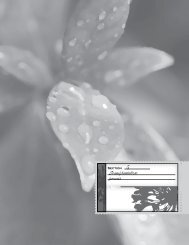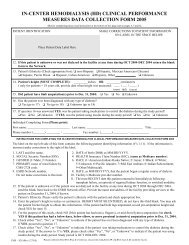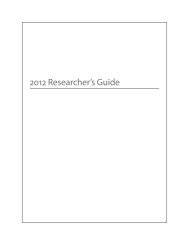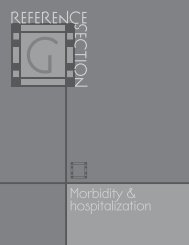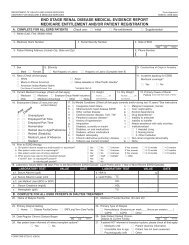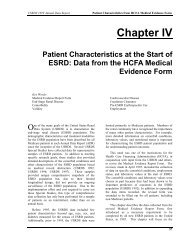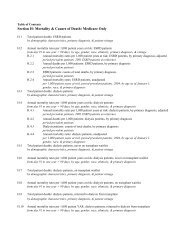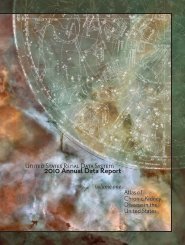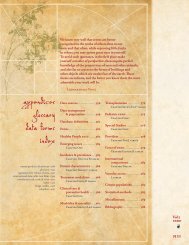Download - United States Renal Data System
Download - United States Renal Data System
Download - United States Renal Data System
You also want an ePaper? Increase the reach of your titles
YUMPU automatically turns print PDFs into web optimized ePapers that Google loves.
non-federal, city/county-government non-federal, hospital<br />
district/authority government non-federal, other-government<br />
non-federal, Veterans Administration Government Federal,<br />
Public Health Service Government Federal, military-government<br />
federal, or other-government federal.<br />
The above 18 categories are designated by the variable<br />
TYPOWNER. The 2002 CMS Survey dropped this variable<br />
and it is missing in subsequent survey periods, starting with<br />
the 2004 SAF CDs. Profit status is now determined from CMS<br />
Dialysis Facility Compare data.<br />
Chain Affiliation<br />
The USRDS definition of a chain is twenty or more facilities in<br />
two or more states owned by the same corporation. The 2006<br />
provider data consists of nine chains based on the USRDS<br />
chain definition. The number of chains can vary from year to<br />
year depending on the change of facility ownership and new<br />
facilities. The chain variable, CHAIN_ID, contains a value<br />
identifying the chain ownership of the facility. A blank value<br />
for CHAIN_ID indicates the facility has no chain affiliation.<br />
Table 8.1 shows chain affiliations and identification codes.<br />
Table 8.1. Chain Affiliations and Codes<br />
Chain Affiliation<br />
DaVita<br />
Dialysis Clinic, Inc.<br />
Everest<br />
Fresenius Medical Care<br />
Gambro Health Care<br />
National Nephrology<br />
Associates<br />
<strong>Renal</strong> Care Group Inc.<br />
<strong>Renal</strong> Treatment Centers<br />
VIVRA<br />
CHAIN_ID Value<br />
(case sensitive)<br />
DAVITA<br />
DCI<br />
Everest<br />
FRESENIUS<br />
Gambro<br />
NATIONAL<br />
RCG<br />
RTC<br />
VIVRA<br />
Freestanding vs. Hospital-based Facility<br />
A hospital-based dialysis facility is one associated with a<br />
hospital; it can be located in the hospital or at a remote location.<br />
Freestanding dialysis facilities operate independently<br />
of a hospital.<br />
A study analyzing freestanding versus hospital-based units<br />
will include three groups: freestanding, hospital-based, and<br />
unknown. The variable NU_HBFS will designate this status.<br />
The number 1 represents hospital-based and 2 represents freestanding.<br />
The unknown category will consist of any provider<br />
in the researcher’s study not found in the Facility database<br />
and must be assigned by the researcher; for example, mat set<br />
NU_HBFS=3 Unknown<br />
Section 9 · Disease-based cohort (5% DM/CKD/CHF<br />
Cohort Finder Files)<br />
With the growing concern of various chronic diseases affecting<br />
the ESRD patients, the USRDS has constructed a set<br />
of disease-based finder files to help researchers gain a better<br />
understanding of causes and effects of these illnesses and<br />
their associations to morbidity and mortality in patients<br />
with ESRD.<br />
<strong>Data</strong> Sources<br />
To create the DM/CHF/CKD cohort finder files by year, the<br />
CC uses 5% General Medicare Claims data (1992-2004)<br />
and ESRD patient demographic information. This information<br />
is available on the USRDS Core CD files “PATIENTS,”<br />
“MEDEVID,” “RXHIST,” and “RXHIST60.”<br />
Each disease-based cohort finder file data set contains three<br />
basic data components, Patient Master File,Payer Sequence<br />
File, and a series of Co-Morbid Files. To illustrate the methodology<br />
used to ascertain patients with the specific disease of<br />
interest and the underlying data structure and file organization,<br />
below is a desscription of how the DM Cohort Finder File data<br />
set was created using the 5% General Medicare Claims data.<br />
The CKD and CHF Cohort Finder Files are similar to the DM<br />
Finder File except they use different ICD-9 diagnosis codes for<br />
identifying their respective diseases.<br />
Patient Master File<br />
The patients in this file had at least one DM ICD-9 diagnosis<br />
code (Table 9.1) identified in the 5% IP, OP, HH, HS, SNF,<br />
and PB SAFs, with one record per patient. The definitions<br />
of the two key variables DM_xx (patient’s one year entry<br />
period DM indicator) and DM_xxyy (two year entry period<br />
DM indicator) are defined as follows:<br />
DM_xx = Y if a patient in year xx (e.g., DM_95 or DM_02)<br />
♦ was Part A and Part B entitled and not enrolled in an<br />
HMO for the entire year (i.e., Payer_Seq_File);<br />
♦ was alive and did not develop ESRD as of December 31<br />
of the year; and<br />
♦ had any one DM ICD-9 diagnosis code from IP or HH<br />
or SNF, or any two DM ICD-9 diagnosis code combinations<br />
from PB or OP with different claim dates.<br />
DM_xx = N otherwise.<br />
DM_xxyy = Y if a patient in a two-year entry period (e.g.,<br />
DM_9596, DM_9900, or DM_0102)<br />
♦ was Part A and Part B entitled and not enrolled in an<br />
HMO for the entire two-year entry period (i.e., Payer_<br />
Seq_File),<br />
♦ was alive and did not develop ESRD as of December 31<br />
of the two-year entry period, and<br />
♦ had any one DM ICD-9 diagnosis code from IP or HH<br />
or SNF, or any two DM ICD-9 diagnosis code combinations<br />
from PB or OP with different claim dates<br />
identified at any time during the two year entry period<br />
(either in one of the two years or across the two years).<br />
DM_xxyy = N otherwise.<br />
Patients with DM_95 = Y are a subset of the patients from<br />
the 1995 co-morbid file (Co_Morbid_95) in the ‘Co-Morbid<br />
Files’ data set; patients with DM_9900 = Y are a subset of the<br />
patients from the 1999 and 2000 co-morbid files (Co_Morbid_99<br />
and Co_Morbid_00) in the ‘Co-Morbid Files’ data set<br />
respectively.<br />
32 e Sections 1-9



